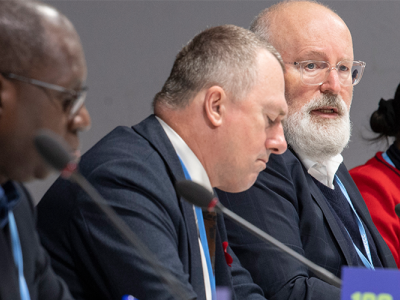
Joint Action to Leverage Impact in Private Sector Development
Serving a diverse group of private sector clients requires tailor-made approaches, integrating mutual reliance and the use of innovative financial instruments to leverage impact.
Can the private sector reduce poverty? Most people would now agree that the private sector drives innovation, and that without it, sustainable growth and employment are not possible. In this sense, the private sector plays a crucial role for economic development, without which it is hard to reduce poverty.
While in the past business people were not often seen at gatherings of the aid community, this had changed, as recognized during last year’s 4th High-Level Forum on development effectiveness in Busan. More controversial is the role of grant aid in involving the private sector in the international development effort. But the EU’s Agenda for Change does lay out an approach to this. For the European Investment Bank (EIB), the recent Wise Persons’ Review of its lending outside the EU clearly pointed to the importance of investment in the local private sector, in particular small and medium-size enterprises (SME) as a key contribution to development.
So what does recognising the role of the private sector mean for the role of State? In fact, far from being pushed out of the picture, the State is more needed than ever. It is the State that must first provide a stable framework of policy, incentives and regulation for investment. Second, of course, the State must also ensure the delivery of many essential services, especially for the poor who might be neglected if full cost recovery is needed. Third, it must remove key barriers identified by businesses, such as the provision of infrastructure and appropriately skilled labour. In this context, EIB lending has a double, even triple role. Our finance aims to bring in private investment, help in overcoming barriers by reducing risks, and help improve the enabling environment through development of infrastructure, whether public or in the form of Public-Private Partnerships (PPP).
Might there not be a danger that the benefits of EIB support are captured by business without contributing to development, or maybe even undermining it? Indeed. This is why we use indicators to measure results and specific conditions in finance contracts, if necessary linked with concessional funds, so as to ensure a contribution to development and compliance with high social and environmental standards that the EU requires.
Sounds easy? No, in fact developing viable project proposals and providing finance to the level needed and at attractive conditions continues to be challenging. Sometimes only foreign investors have the expertise required. Yet they often believe that the risk of investing in certain developing countries is too high. It is a key role of IFIs to incentivise them to take more risk, whether by a signalling effect, or perhaps mitigation of a particular risk, for instance by providing a guarantee against expropriation. The local private sector is also often risk-averse. For instance, local banks may find safer investments than SMEs, or green technologies. They may need an incentive such as longer-term loans. For both local and foreign investors, technical assistance and financial advisory services play a crucial role. They support the preparation of business plans or enable technical review, and support partners in structuring of projects.
The private sector is not monolithic. It is made up of many different players, from micro-entrepreneurs to multi-nationals. So a broad set of financing instruments is required, for which there is more likely to be demand if they are not readily available on the local and international markets. Between 2009 and 2011, the EIB deployed direct and global loans, bank-intermediated loans, as well as direct equity and indirect equity via funds, in total €13.9bn to the private sector outside the EU, of which €5.4bn went to the SME sector. Overall, private sector support represented more than 50% of the total portfolio in the regions outside EU. What is important is that these volumes are estimated to have leveraged at least the same amount of additional funding from the borrower’s side.
The EU has set out an Agenda for Change to make the private sector do much more for development. The use of innovative financial instruments, which blend EU grants with funds from financing institutions like the EIB was seen as be a powerful tool to leverage private sector support. But scarce grant funds must not be misused. Such blending has to follow a clear-cut policy. That is, it should be targeted specifically at approaches that require additional subsidies, but at the same time it must generate revenues high enough to make grants go much further. This way, applying blending instruments, most common in the economic infrastructure and the financial sector, does not compromise on development impact but rather increases it.
Another advantage is that since blending will involve at least two financing partners, individual contributions are considered as an overall package. This often goes in tandem with an alignment of approaches and strategies, thus increasing efficiency and avoiding duplication of efforts. The Mutual-Reliance-Initiative (MRI), initiated by the AFD, KfW and EIB and based on a reciprocal recognition of procedures and joint actions, serves as an excellent example of these efforts. Such close cooperation with other financing institutions and partner governments should contribute to avoiding market-distortions and ensuring real development impact.
Increased private sector development, use of blending instruments and mutual reliance amongst financing agencies all have huge potential for boosting development impact, if applied in combination with other instruments. But the devil is in the detail. A sound analysis on a case-by-case basis and a responsible choice of an adequate set of interventions will remain key to success.
Ms Tamsyn Barton is Director General for Operations Outside the European Union, European Investment Bank
This article was published in Great Insights Volume 1, Issue 8 (October 2012)


